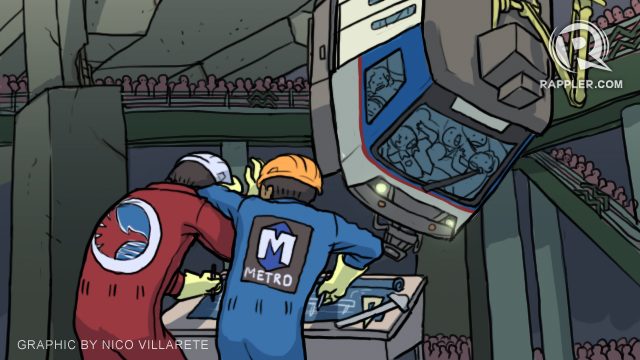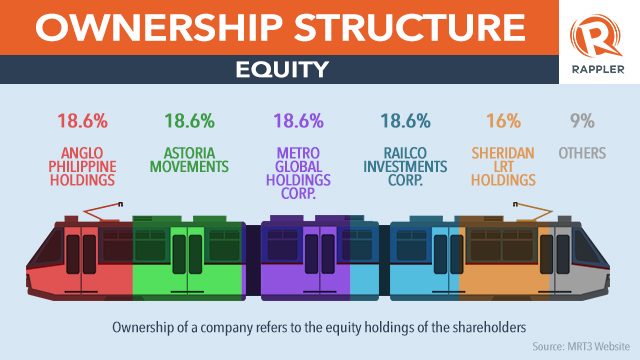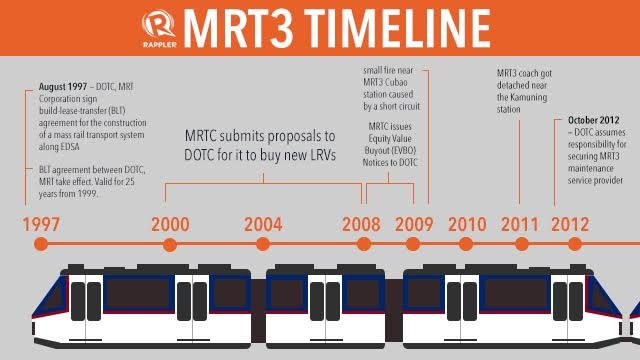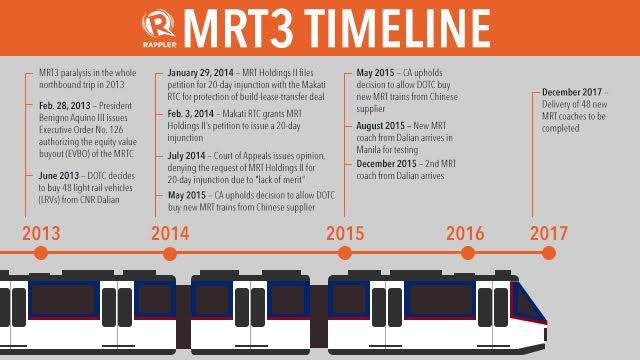SUMMARY
This is AI generated summarization, which may have errors. For context, always refer to the full article.

MANILA, Philippines – The conglomerates of Ramon Ang and Manuel Pangilinan have renewed their interest in the rehabilitation of the Metro Rail Transit Line 3 (MRT3), after the administration revived plans of completely buying out the glitch-ridden mass transit railway’s private stakeholders.
Although the 2017 national budget did not allot funds for the equity buyout of MRT3, the transportation department said gaining full control of MRT3 is the current administration’s direction. (READ: When the MRT was awesome)
The government has been under fire for technical glitches and long queue lines due to inadequate train sets.
It is during rush hour – mornings when passengers travel to work and early evenings when they return home – that riding the MRT3 becomes agonizing, with passengers packed in train cars like sardines after waiting for hours.
An equity buyout would allow the government to push through with MRT3 rehabilitation, bid out its operation and maintenance to private sector, end an arbitration case filed by MRTC, and allow it to manage the financial burden imposed by the build-lease-transfer (BLT) deal.
The MRT Corporation (MRTC) is the private group that was a signatory to the build-lease-transfer (BLT) agreement for MRT3 in 1997.
The government is in charge of the operations of the light railway, while a 3-year maintenance contract was awarded to Busan Universal Rail Incorporated.
The government has been paying rental of at least P610 million a month to the MRTC for the past 15 years. There are 7 to 8 more years left before the contract expires.

The government holds a 77% economic interest in MRTC through Landbank and Development Bank of the Philippines (DBP) by virtue of its acquisition of asset-backed bonds issued by MRTC’s original owners in 2009. This secured the government 11 of the 14 board seat but does not give them equity ownership.

With the administration of President Rodrigo Duterte planning to takeover MRT3 ownership and then bidding out its operations and maintenance to the private sector, two of the largest conglomerates in the country were quick to express interest.
“If the government is willing, we can submit. We have expressed our interest long ago,” Ramon Ang, president and chief operating officer of San Miguel Corporation, told reporters on the sidelines of an event in Pasay City on Friday, June 2.
Manuel Pangilinan, chairman of Metro Pacific Investments Corporation, have said his firm has informed the administration of its plan to revive its MRT3 upgrade unsolicited proposal.
“We are thinking of resubmitting our updated proposal on MRT3. We’re being responsive to the needs of the people. In the end, it is up to the government,” Pangilinan had told reporters.
During the administration of former President Benigno Aquino III, Metro Pacific had submitted a revised P23.3-billion proposal to rehabilitate and upgrade MRT-3.
Metro Pacific’s revised offer, which is a scaled-down version of a P25.1-billion proposal submitted in 2011, included the rehabilitation of existing train cars, 25 additional coaches, a new signaling system, and settlement of the government financial institutions-held equity rental payments. The previous administration, however, sat on this proposal.
Ang of San Miguel said he is willing to partner with Metro Pacific for the upgrade of MRT3.
“We can work with anybody. We are close with Metro Pacific. We are very close to the Zobels, we are very close to Mr. [Henry] Sy of Shoemart, we are very close to everybody, and we intend to work with everybody,” Ang told reporters.
MRT3 mess
But how did the MRT3 mess start? It dates back to August 1997 when MRTC and the government signed the BLT agreement. It was in 1999 when MRT3 was opened to decongest EDSA. Now, EDSA remains congested.


Aquino on Feb. 28, 2013 issued an executive order, authorizing the MRT3 equity buyout partly to head off the arbitration case filed in 2009 by the MRT3 owner against the government due to, among others, failure to pay equity rental payments on time.
At present, the MRT3 runs from North Avenue station in Quezon City to Taft Avenue station in Pasay City. In 2016, MRT3 had 10.27 million passengers, up from the 9.85 million passengers recorded in 2015.
In 2016, the transportation department reported 586 unloading incidents.
This year, Department of Transportation data showed over a hundred unloading incidents so far.
Almost half a million passengers ride MRT3 daily, frustrated by the long waiting lines, service interruptions, and breakdowns.
Now, it is up to the current administration on how it will solve the MRT3 woes. – Rappler.com
Add a comment
How does this make you feel?
There are no comments yet. Add your comment to start the conversation.